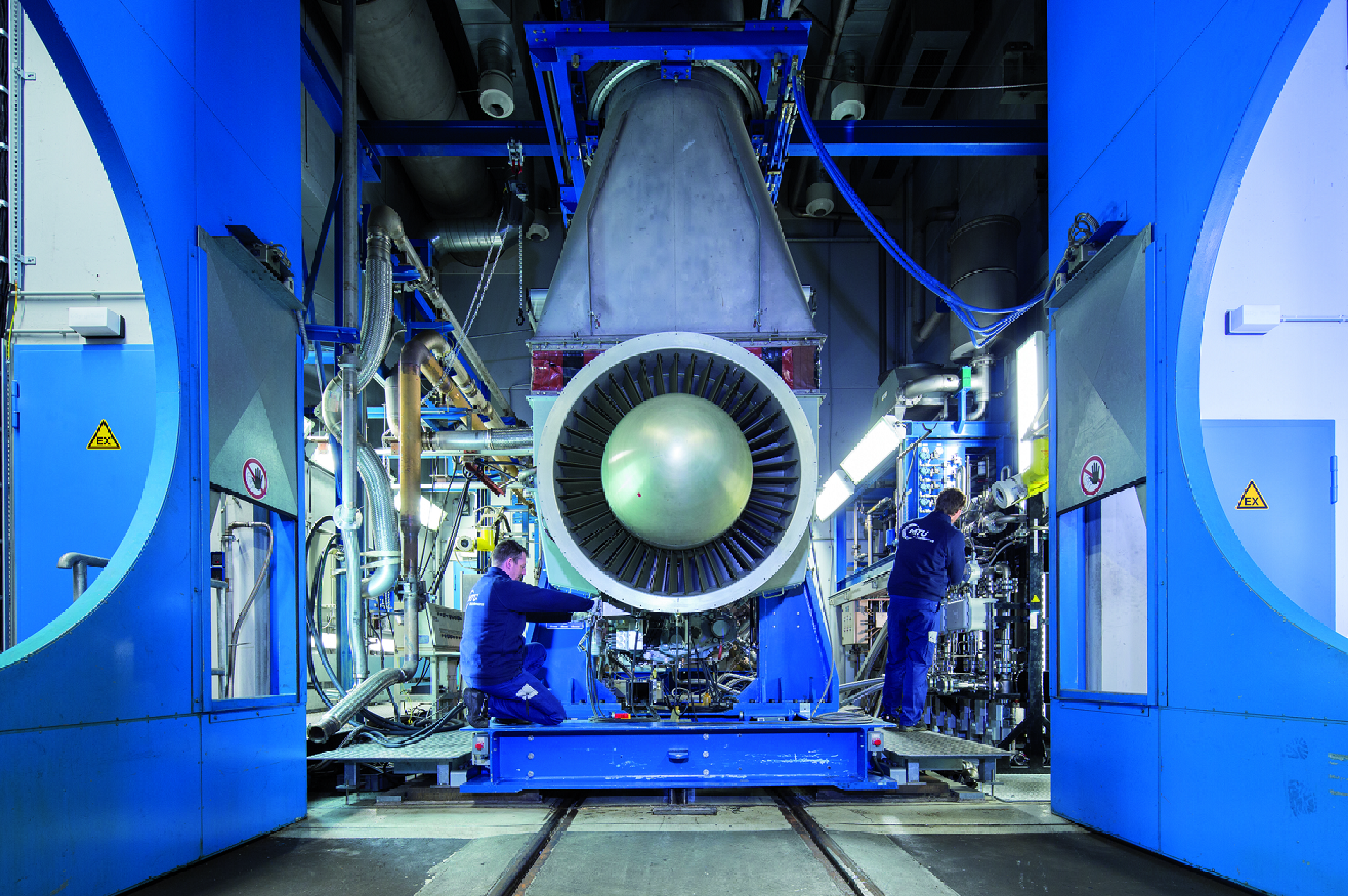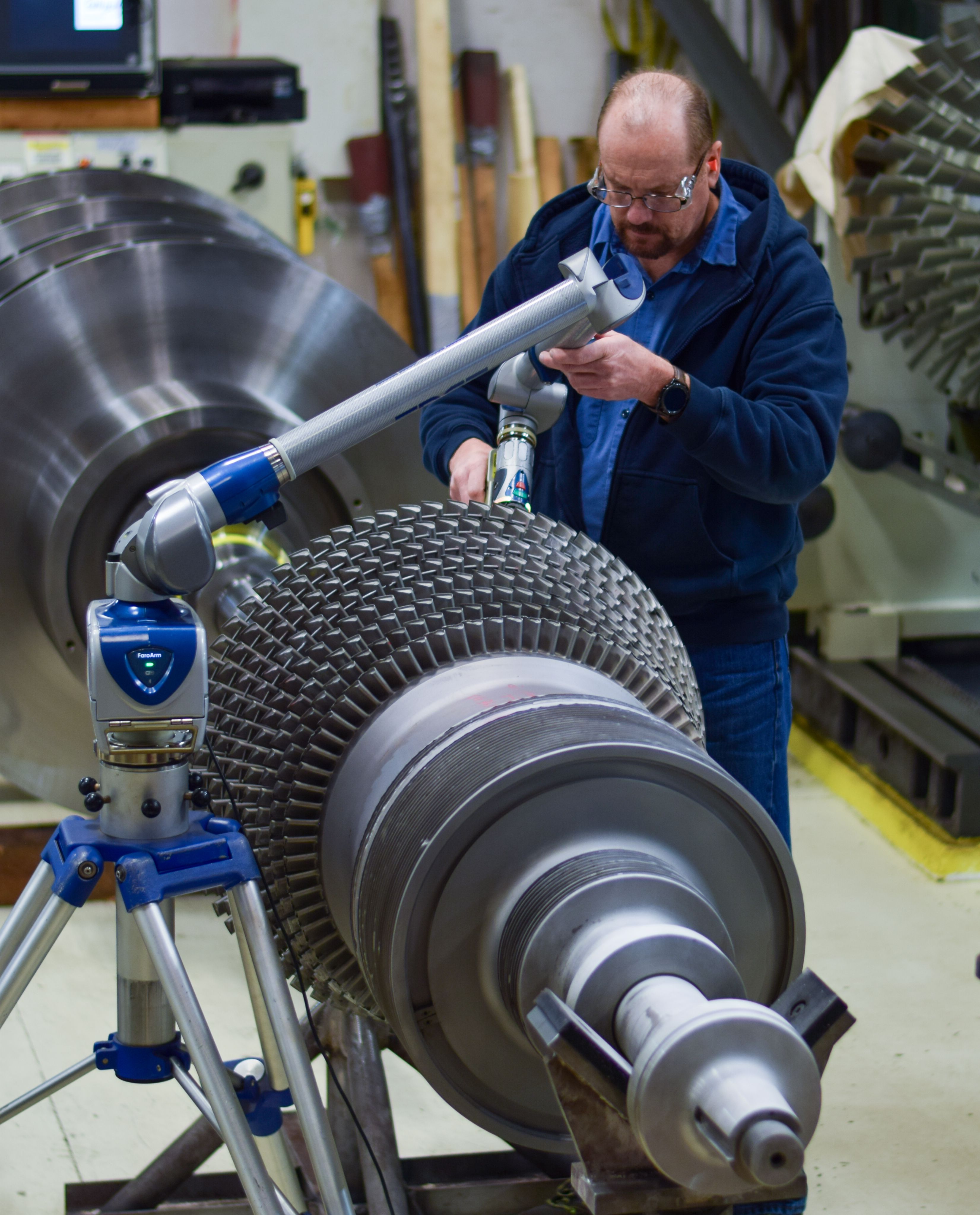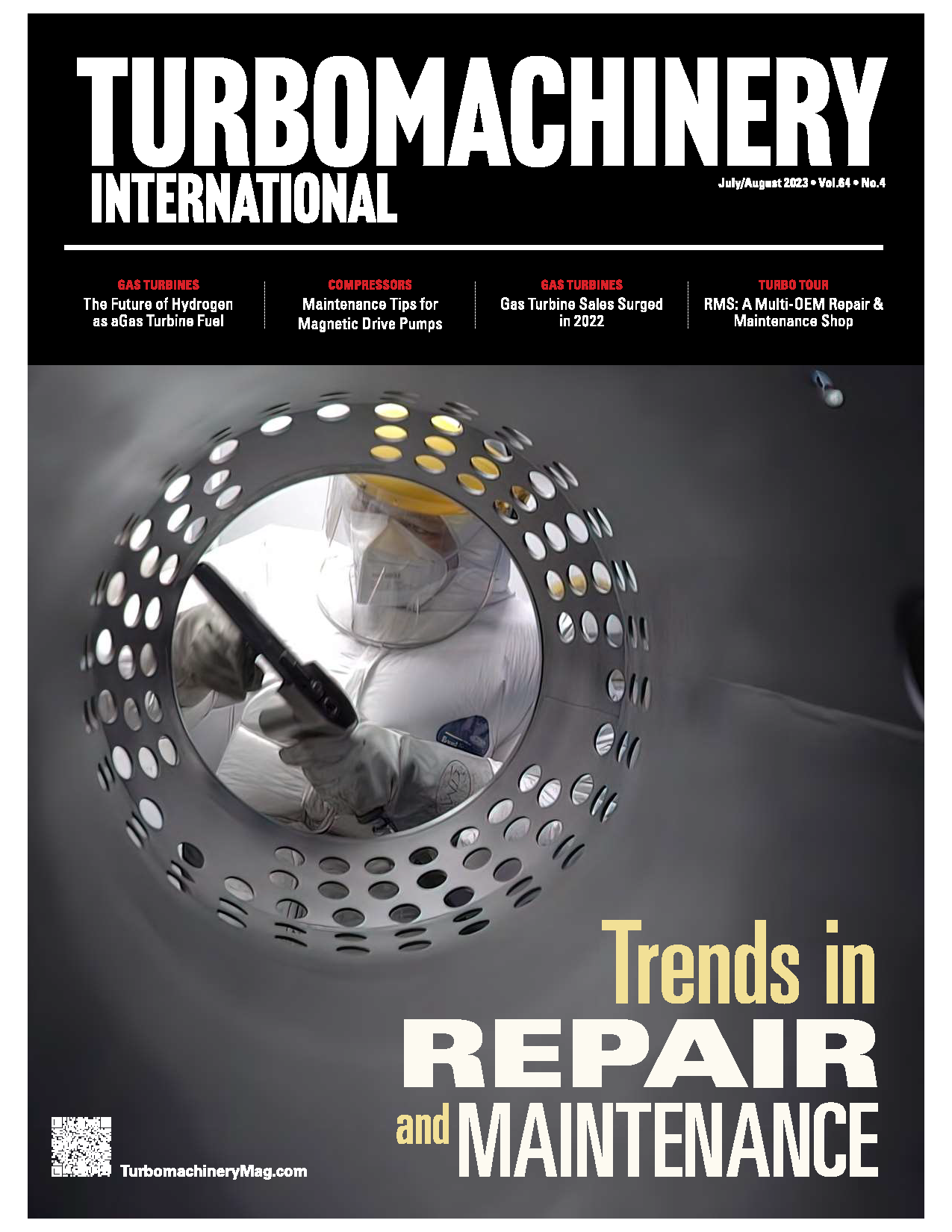Repair & Maintenance Trends Necessitate Tech Innovations
Emerging market dynamics continue to play a role in the turbomachinery repair and maintenance landscape, leading to inventive methodologies.
Mechanics work on an LM6000 industrial gas turbine at the MTU Maintenance Berlin-Brandenburg shop in Ludwigsfelde, Germany. Credit: MTU

The gas turbine maintenance, repair, and overhaul (MRO) market continues to show signs of growth due to an aging fleet of gas turbines and government interventions to reduce carbon emissions, among other factors. According to the market research firm Lucintel, the gas turbine MRO market is expected to reach an estimated $17.8 billion by 2024 and was forecasted to grow at a compound annual growth rate (CAGR) of 3.4% from 2019 to 2024.
“The existing fleet of gas turbines from the construction wave of the late 90s to early 2000s will soon require extensive maintenance,” said Mike Petticord, Plant Manager at IHI Power Services Corp.
In fact, Research and Markets’ 2018 trends and forecasting report anticipated that the equipment in this aging fleet would require significant MRO services. The firm forecasted that in the next 10 years (2018 – 2028) an investment of $256.77 billion would be made for the commissioning of 17,680 gas turbines (excluding microturbines).
“OEMs and aftermarket suppliers are moving toward selling capital spares and seed components to allow for part exchanges and rotable spares as a way to ensure parts are drop-in ready versus the traditional process of inspecting, removing, repairing, and re-installing during a single outage occurrence,” Petticord said.
This driving factor, among others, is not only furthering the MRO market, but it’s driving technological innovations, trends, and a total shift in how the industry approaches repairs and maintenance.
Trends in Repairs
The industry has seen several shifts in the repair of gas turbines and compressors, including a shift away from value-added solutions toward an economic-based approach to component repairs, according to Chris Wilkinson, Senior Vice President, Growth for EthosEnergy. The industry has been impacted by labor shortages and supply chain availability issues, which is translating into more repairs versus replacements and postponing repairs.
Increased Repair Intervals
“In the past, customers would perform parts repairs immediately after an outage, but now they are pushing repairs, sometimes waiting two to three years [after an outage],” Wilkinson said. “This trend is driven by not only the aging nature of the fleet but also by political and environmental uncertainties.”
He said that because customers are looking to extend parts intervals and rotor life, they are more open to upgrading control systems, implementing combustion auto-tuning, and remote plant monitoring. The company performs approximately 30% of its repairs onsite, 60% in-shop, and 10% remote.
“The remote option is growing and will continue to do so in the coming years as technology advances and decisions at the plant ownership search for greater efficiencies,” Wilkinson said.
Gregor Stöcker, VP of Sales Industrial Gas Turbines at MTU Maintenance Berlin-Brandenburg, said there is an emphasis on repairing versus replacing parts for gas turbine engines. “In fact, due to the supply chain pressures, overhauled parts have become quite valuable within the MRO process,” he said.
As a result, MTU is focusing on bolstering its inventory of exchange parts by acquiring engines for teardown and sourcing individual parts. “The new material supply chain issues have caused such parts and engines to increase in popularity, which in turn, drives purchase prices upwards,” Stöcker said. “[But] we are able to handle engines in-house, salvage and repair parts, and know what a fair market value is for mature engines and used serviceable material.”
In fact, the company works as much as possible onsite to save transportation costs for its customers. MTU has a field service team and global network of level II IGT service centers next to its Ludwigsfelde, Germany facility. “However, working onsite has some technical limitations and depends on the work scope required,” Stöcker pointed out. Yet MTU also has remote capabilities to monitor a gas turbine engine. For example, to flag potential issues and make recommendations about shop visits.
Although in-shop work is ideal, Kraig Simpson, VP of Technology at Rotating Machinery Services (RMS), said the company’s current technology enables some turbomachinery field overhauls to be executed 50% of the time versus historical maintenance times. “Gone are the days of lifting a compressor rotor in and out of a casing to adjust clearances via tape checks,” he explained. “We are no longer required to use a mandrel to align diaphragms in a steam turbine. It’s not necessary to rotate rotors to perform shaft end alignment. We can even digitally dowel components to replicate their relative position and alignment. Virtual assembly changes the game, even in the field.”
Increasing Part Longevity, Integrity
Given the trend toward repairs versus replacements, parts need to last longer and have an increased tolerance. To adapt to evolving changes, “Both OEMs and aftermarket service providers remain highly focused on increasing part longevity, enabling longer service intervals, optimizing reliability, and enhancing operating flexibility, i.e., better turndown, fuel flexibility, etc.,” Petticord said.
However, many components and materials are evolving and need further refinement, such as “better material sourcing for thermal barrier coatings to elevate service intervals, stellite coating enhancements, and metallurgical advancements for single crystal parts to allow higher firing temperatures while escalating fatigue life,” according to Petticord.
Doug Nagy, Manager, Components Repair at Liburdi Turbine Services, said he’s noticed increasing complexity of component design, manufacturing, alloys, and coatings used. “As a result, many new components, especially thin-walled castings, are less tolerant of service damage, i.e., corrosion, impact damage, etc., and so reparability suffers,” he said. “Further, access to data and know-how on proprietary methods and materials hinders independent reparability options.” That said, Nagy did point out that independent shops are “upping their game in business practices and technology” and are developing and/or acquiring more in-house capabilities.
Labor Shortages
Among these repair trends, one universal issue in most industries is labor shortages. Because the workforce has changed significantly in recent years, factors such as shortages, retirements, and an overall lack of expertise/skilled workers have become more prevalent.
Credit: IHI Power Services Corp.

Petticord said that many technical and craft industry experts have retired. “The pandemic acted as an obvious catalyst for these problems and has left a lasting impact on staffing skilled field crews and technical experts, both of which are currently in high demand for field and shop services.” This deficiency can push OEMs and service providers to hire less-experienced workers, leverage subcontractors, or hire local craft workers with limited gas turbine experience.
“To ensure quality, owners and O&M providers must have adequate technical oversight in place during maintenance outages to ensure its standards are being met at the highest level,” Petticord said. Because of the scarcity of field resources, he said there’s been a major shift toward in-house shop work. “That, along with proper planning allows a more leveled playing field for shop resources throughout the year as teams manage peaks of heavy outage season demand.”
New Approaches to Maintenance
Many of these trends have pushed the industry to reinvent its approach to maintenance—be it because of labor shortages, the need for more durable, sustainable components to increase run times, increased outages, prolonged maintenance scheduling, or others. Data-based approaches like predictive and preventive maintenance as well as remote monitoring, augmented reality (AR), and 3D mapping are being beneficially adopted with more frequency in repair and maintenance practices.
“We must look beyond the next outage for gas turbine units,” Wilkinson said.
“The critical question is, ‘How long does this unit need to run?’ This dictates the approach to maintenance and the investment in the unit, whereas historically it was a very standardized approach to outages and repairs. Today, there is a much different approach based on whether the unit will run for 5-7 years as opposed to one that is planned to run for 15-20 years. We have to be flexible to meet these needs in the market and understand that no situation will be alike. It’s truly a customized approach.” EthosEnergy’s rotor life extension program offers hybrid Phoenix Rotors with new and Certified Previously Operated parts to support this need for flexibility.
Predictive maintenance approaches continue to rise to reduce machine downtime and increase early detection. “Online technologies such as blade-health monitoring systems for rotating components and acoustic monitoring of stator parts have been integrated into remote monitoring to establish early problem-detection capabilities,” Petticord said.
“There is a renewed focus on predictive analytics, including sensor health monitoring and process data validation, which can be used alongside the software improvements to maximize reliability, optimize performance, and extend componentry lifetimes.”
Howden minimizes machine downtime using data with a focus on scheduled and predictive maintenance. Ellie Smith, product manager of augmented reality at Howden, said the company uses real-time augmented reality (AR)-enabled video calls to triage and diagnose problems, carry out inspections, monitor testing, supervise newly qualified engineers, and even enable its customers to carry out some basic repair and maintenance tasks themselves or with help from Howden.
“Customers want a quick reaction, lower costs, first-time fixes, etc,” Smith explained. “Howden Virtual Expert, our AR-based remote support platform, is a mobile-based app that shares a view of the user’s environment with Howden experts from all over the business. Everyone on the call can interact by making 3D annotations.”
The increased need for rapid repairs has been largely driven by longer equipment run times associated with postponing repairs and scheduled maintenance. It’s also resulted in an increase in unplanned outages, requiring around-the-clock repairs to restore operation, Simpson said. Subsequently, “The old way of performing dimensional inspections and setting clearances manually are now incompatible with market demand,” he said. “Customers are shifting away from time-based maintenance intervals and opting for condition-based monitoring. The industry desires a more visual way of working to capture critical data during each outage so that the accumulated data can be used for subsequent outages to drive continuous improvements in maintenance-related activities.”
The company’s use of precision measurement technology to virtually assemble equipment relies on a 3D platform that digitally maps the geometry of a spare compressor or turbine rotor, after which it digitally maps the corresponding casing internals to virtually overlay the rotor into its casing. “This enables us to identify and optimize internal clearances before physically installing the rotor,” Simpson explained. “When we install the rotor in the machine, we know it will fit the first time without the need for additional measurements and adjustments.
“We’re no longer taking an iterative approach to maintenance,” Simpson said. “We are not constrained to historical maintenance techniques. This technology enables us to take a step back and completely reimagine how we approach maintenance.”
New and 'Used' Services
Newer maintenance approaches, such as predictive and preventative maintenance, in addition to newly created virtual offerings, require innovation—either from technology upgrades or advancements.
Companies such as RMS have created a new technology team focused on using precision measurement and laser mapping tools, and it is also working to support virtual learning by incorporating models of equipment captured through digital scanning.
“We are creating a more visual way of working so that customers can interact with a realistic 3D simulation of the intricate details associated with overhauling a complex turbomachine,” Simpson said.
A mechanic uses Faro arm to scan rotor to
gather critical fit measurement.
Credit: Rotating Machinery Services

Howden is creating an AR addon to Uptime, its performance monitoring digital platform that uses data to analyze rotating equipment performance. The addon is a new way to visualize and interact with live data and analytics in the field by scanning a machine barcode. It allows the user to explore the 3D model and custom animations to understand issues, identify replacement parts, submit machine condition reports, and more. The company is also introducing self-service guided instructions for customers to carry out minor tasks themselves.
Nagy said that in the past it was rare to have a full metallurgical lab capability, but now it’s essential to perform routine quality control/assurance and collect post-service evaluations of service damage. “This allows feedback to users on durability of parts and repairs,” he said. “And it allows shops to develop specific repair ‘prescriptions’ for parts rather than relying on non-optimized generalized work scopes.” Liburdi Turbine Services conducts component inspections to identify non-reparable parts early in the shop-flow process.
EthosEnergy continues to perform ICON control system upgrades, ECOMAX combustion auto-tuning, and a range of site audits. It is also developing Advanced Gas Path parts, a remote operations center in the United States, and an expansion of its compressor capabilities in its Houston Service Center.
MTU is expanding its LM6000PF+ engine services from module MRO to the complete spectrum, including full overhaul and test.
The Future of Repair and Maintenance
Similar to steam turbines, Wilkinson said the trend will continue to shift more toward condition-based maintenance of gas turbines. “Maintenance and repair will be less routine, and owner/operators will continue to push the limits of their units for economic, environmental, and political reasons.,” he said. “This will result in an increase in forced outages and unplanned events.”
With the ongoing labor challenges, Petticord said, “Service providers must stay diligent in using seed parts to allow major component and rotating spare exchanges during outages.” He anticipates a larger emphasis on upgrades in fuel flexibility, such as incorporating hydrogen. “In the long-term, 3D printing of suitable components may eventually alleviate supply chain issues by allowing the creation of just-in-time spares to deploy,” he said.
Overall, utilizing these newer approaches, such as 3D capabilities, data-based approaches, predictive and preventative maintenance, and precision measurement technologies, can support the industry’s desire to reduce turnaround times, increase run times, and reduce downtimes during outages.
